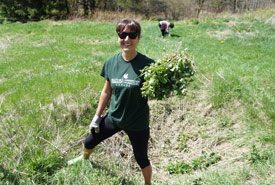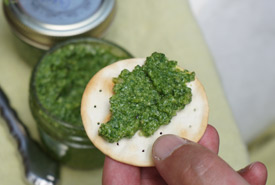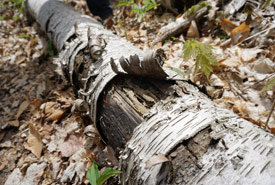Cracking down on garlic mustard: A delicious and therapeutic experience

Garlic mustard are no match against our staff (Photo by NCC)
On May 12, Nature Conservancy of Canada (NCC) staff had the opportunity to step away from their desks to crack down on invasive garlic mustard at the Happy Valley Forest.
Commanders of the day, Todd Farrell and Mark Stabb, asked us to form pairs and work our way up a slope infested with garlic mustard. We were also surrounded by plenty of black locust trees, which are often found with garlic mustard.
NCC’s new Happy Valley Forest conservation technicians, Jenna Siu and Stephanie Varty, were a great help throughout the day. They shared their knowledge of the area and ensured we were well looked after.
After a morning of combing through the forested slopes, carefully evading the prick of raspberry brambles, we managed to remove at least a large garbage bag’s worth of these garlicy invaders per team. Many staff (including me) found this activity highly therapeutic. Looking at greens rather than my screen was a nice change!

Garlic mustard pesto spread (Photo by NCC)
By lunch time, we had filled close to 40 bags (300 kilograms) of this invasive plant. Take that, garlic mustard! We were told the day’s efforts were likely the biggest garlic mustard removal project to date in the area.
Just before lunch, we had a taste of our spoils. Local Chef Marc-Alain created a savoury garlic mustard pesto from the first picking.
“Delightfully refreshing” and “perfect for summer” are some common critiques for what I thought was a palette-cleansing spread. One staffer even went on to describe the flavour as “not very garlicy and more like, ‘wheatgrass-meets-kale.’”
After this culinary encounter and having refueled on our lunches, we were joined by NCC donors Ann and David Love, who talked about the Barnett Woods property. Ann spoke of her family’s heritage and memories at this estate, including a landmark spot called the Four Oaks Corner that was frequently used as a meeting spot.
Todd later led us on a hike through the scenic hills of the Deep Woods property. There, many of us had a moment to marvel at the brilliant red of the scarlet tanager that rested quite a ways up on a tree top, but still clear enough to see with the naked eye.
Many plants were introduced along the way, including a jack-in-the-pulpit at the entrance of the property and a blue cohosh, which bears inedible blue-coloured berries, found along a ridged area. We saw many living plants but also crossed paths with numerous fallen trees.

Decomposing birch tree (Photo by NCC)
Todd pointed out the importance of fallen trunks, which provide habitat for salamanders, insects and many other species; dead trees become bustling with life by supporting a micro-ecosystem that would otherwise not be there. So while we may have a tendency to advertise the larger plants and animals when talking about what’s being protected on a property, it is also these tiny fungi, moss, insects and so on that are being protected through land conservation.
By day’s end, staff were all smiles as they boarded their ride home. The day’s trip will be a strong reminder of the results and work still to be done as we return to our office jobs, many of which have no real field exposure.


